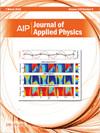Nickel stanogermanides thin films: Phases formation, kinetics, and Sn segregation
IF 2.5
3区 物理与天体物理
Q2 PHYSICS, APPLIED
引用次数: 0
Abstract
Ge1−xSnx thin films with a Sn content of x ≥ 0.1 present a direct bandgap, which is very interesting for the fabrication of efficient photonic devices. The monostanogermanide phase, Ni(GeSn), is promising to form ohmic contact in GeSn-based Si photonic devices. However, the formation kinetics of Ni stanogermanides and the incorporation of Sn in Ni–GeSn phases are not fully understood. In this work, Ni thin films were deposited on Ge and Ge0.9Sn0.1 layers grown in epitaxy on an Si(100) substrate using magnetron sputtering technique. In situ x-ray diffraction measurements were performed during the solid-state reaction of Ni/Ge and Ni/Ge0.9Sn0.1. 1D finite difference simulations based on the linear parabolic model were performed to determine the kinetics parameters for phase growth. The nucleation and growth kinetics of Ni germanides are modified by the addition of Sn. A delay in the formation of Ni(GeSn) was observed and is probably due to the stress relaxation in the Ni-rich phase. In addition, the thermal stability of the Ni(GeSn) phase is highly affected by Sn segregation. A model was developed to determine the kinetic parameters of Sn segregation in Ni(GeSn).锡锗化镍薄膜:成相、动力学和锡偏析
Sn 含量 x ≥ 0.1 的 Ge1-xSnx 薄膜具有直接带隙,这对于制造高效光子器件非常有意义。单锗化物相 Ni(GeSn)有望在基于 GeSn 的硅光子器件中形成欧姆接触。然而,人们对镍晶锗化物的形成动力学以及镍-锗-锡相中锡的掺入还不完全了解。在这项研究中,使用磁控溅射技术在硅 (100) 基质上外延生长的 Ge 和 Ge0.9Sn0.1 层上沉积了镍薄膜。在 Ni/Ge 和 Ni/Ge0.9Sn0.1 的固态反应过程中进行了原位 X 射线衍射测量。根据线性抛物线模型进行了一维有限差分模拟,以确定相生长的动力学参数。锡的加入改变了锗化镍的成核和生长动力学。观察到 Ni(GeSn)的形成延迟,这可能是由于富镍相中的应力松弛造成的。此外,镍(GeSn)相的热稳定性受到锡偏析的严重影响。我们建立了一个模型来确定镍(GeSn)中锡偏析的动力学参数。
本文章由计算机程序翻译,如有差异,请以英文原文为准。
求助全文
约1分钟内获得全文
求助全文
来源期刊

Journal of Applied Physics
物理-物理:应用
CiteScore
5.40
自引率
9.40%
发文量
1534
审稿时长
2.3 months
期刊介绍:
The Journal of Applied Physics (JAP) is an influential international journal publishing significant new experimental and theoretical results of applied physics research.
Topics covered in JAP are diverse and reflect the most current applied physics research, including:
Dielectrics, ferroelectrics, and multiferroics-
Electrical discharges, plasmas, and plasma-surface interactions-
Emerging, interdisciplinary, and other fields of applied physics-
Magnetism, spintronics, and superconductivity-
Organic-Inorganic systems, including organic electronics-
Photonics, plasmonics, photovoltaics, lasers, optical materials, and phenomena-
Physics of devices and sensors-
Physics of materials, including electrical, thermal, mechanical and other properties-
Physics of matter under extreme conditions-
Physics of nanoscale and low-dimensional systems, including atomic and quantum phenomena-
Physics of semiconductors-
Soft matter, fluids, and biophysics-
Thin films, interfaces, and surfaces
 求助内容:
求助内容: 应助结果提醒方式:
应助结果提醒方式:


